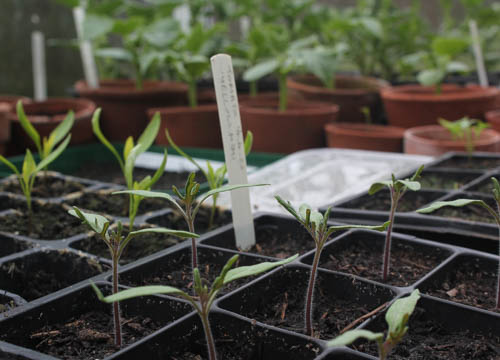
Now’s the time to sow outdoor cucumber like ‘Marketmore’, marrow, squashes, pumpkins (vertically on edge, not laid flat like a surf board) individually in 7.5cm pots plus French and Runner beans and Sweetcorn in gentle heat in peat substitute seed compost or sieved multipurpose compost in a propagator, ready for planting out once the danger of frost has passed. If the weather is still changeable, keep sowing salads for transplanting.
Tie in the main stems of tomatoes, peppers and aubergines into supporting canes as they grow, using soft twists or twine.
Continue to prick out and pot on seedlings, gradually increasing the pot by one or two sizes each time until they reach the final pot size for plants like aubergines or chillis which are being grown on in the greenhouse. If not, repot as needed until they are ready for ‘hardening off’.
Paint your glasshouse with shading or close the blinds on sunny days and open the vents to prevent overheating. Avoid opening the doors if the wind is cold, to avoid damaging plants near the entrance. Plants may need watering twice a day.
Increase the space between greenhouse plants as they grow and check plants daily for pests and diseases (small populations are easier to control) removing yellowing and fallen leaves to prevent problems from spreading. Zap any you spot with SB Invigorator or similar environmentally friendly controls.
Outdoor plants will need ‘Hardening off’ before transplanting. This will take two to three weeks, depending on the plant, the temperatures at which it grew while under cover and the location of the garden. Hardy plants acclimatise more rapidly than half-hardy or tender plants.
Transfer plants from heated to cooler conditions on a cloudy day, or cover them with newspaper or fleece at first to protect them from scorching or wilting.
Put your plants at the base of a sheltered south facing wall or hedge during the day and protect them for the first few days, with a couple of layers of fleece. Bring them indoors at night. Cover them with a single layer of fleece for the first part of week two. After about 10 days, depending on the weather, remove the fleece during the day and leave plants outdoors at night if it’s mild. Leave them uncovered day and night towards the end of the third week, before finally planting out. Timing is critical: tender plants should not be planted out until after the last frost in your area. Listen to weather forecasts and have cloches, fleece or newspaper, ready should late frosts catch you out. Tender plants can be damaged if hardened off below 12C(54F), Petunia, lobelia, Tagetes need consistent temperatures around 10-12C (50-54F), tender bedding like pelargoniums and Bizzy Lizzie, can be planted when minimum night and day temperatures are 10C (50F) and 14-16C (57-61F) respectively.
We are so fortunate to be able to garden during difficult times like these. Fingers crossed that the garden centres and nurseries will be open again soon to #KeepBritainBlooming
Happy Gardening and stay safe, Matt










